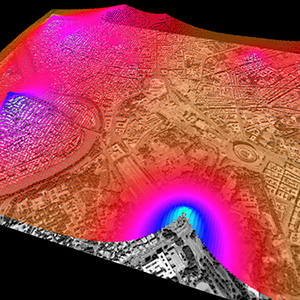
The well-known Wired Magazine put his name to its list of “50 people who will change the world” considering his way of thinking about future energy efficient cities where architecture senses and responds. The concept of Carlo Ratti is called “SENSEable City”, a real-time city concept that is currently developed as a new research initiative at the Massachusetts Institute of Technology. He will be one of the jury members for the Prix Ars Electronica 2014 of the category “Digital Communities” and talked to us about his idea. Take part and submit your work to the Prix Ars Electronica 2014 now! The extended submission ends on 19th March 2014 (23:59 CET)!
“Senseable cities” – what’s it all about?
Carlo Ratti: I don’t know if we will change the world, but we are doing our best to improve the quality of life in cities. At the SENSEable City Lab we are excited to investigate how technologies are changing our cities. For us, the word “Senseable” has a double implication; it means “able to sense” and “sensible”. We prefer to use the term Senseable City – instead of Smart City – because it puts the human at the center: the common denominator for all of our projects, in fact, is that they are focused on people, rather than technology. We believe in a ground-up approach to creating cities in which people become the agents of change.
It’s your first time as a jury member and you will judge the submitted works of the category “Digital Communities”. What general conditions do you think are their best breeding ground – is it more than open access to public data?
Carlo Ratti: Open access to public data is an important condition. We have an unprecedented ability to understand and react to the world around us – whether it is the natural world, the built environment, or the social and connective landscapes of human networks. For instance, we just installed in Singapore an exhibition called Data Drives: an intuitive software tool for manipulating and visualizing the wealth of information generated by the city. Big Data is no more the domain of large team of specialists; it’s now becoming accessible to anybody. Data allow us to better understand reality, catching the “pulse of the city”. It is then important to respond to the recorded information, i.e. to “actuate the city”. Actuation can happen in many forms and, above all, through people.
How can we profit from modern technologies in the future, if we think about digital communities?
Carlo Ratti: It is really about the sensing and actuating loop: feedback and response in real time. Take many present day examples: users of Waze automatically upload detailed road and traffic information so that their community can benefit from it. 311-type apps allow people to report non-emergencies in their immediate neighborhood, from potholes to fallen tree branches, and subsequently organize a fix. Open Street Map does the same, enabling citizens to collaboratively draw maps of places that have never been systematically charted before — especially in developing countries not yet graced by a visit from Google.
You’ve found new ways of collecting existing data like cellphone activities during soccer games or newly generated data like tracking waste within several weeks. How did you come up with these unusual ideas?
Carlo Ratti: The amount of data we generate today is impressive. As you know, according to Google’s executive chairman Eric Schmidt the amount of data produced from the dawn of civilization up until 2003 is now generated every couple of days – an estimation itself a few years old. This is the domain of “Big Urban Data”. In our lab we are interested in revealing and sharing with people its hidden dimensions – such as the one you mentioned. Again, the focus should be citizen response, i.e. actuation. For instance, one of the things we learnt from the Trash Track project you mentioned is that sharing information can change people’s behavior. People involved in the project wereable to follow their trash and this prompted may of them to change their habits. One person told us: “I used to drink water in plastic bottles and throw them away and forget about them. Now I know that they just go a few miles form home to a landfill, and I cannot forget about them anymore. As a result, I stopped drinking water in plastic bottles…”
Be part of the Prix Ars Electronica 2014 and submit your work!
